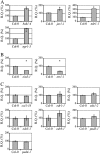Interfamily transfer of tomato Ve1 mediates Verticillium resistance in Arabidopsis
- PMID: 21617027
- PMCID: PMC3149960
- DOI: 10.1104/pp.111.180067
Interfamily transfer of tomato Ve1 mediates Verticillium resistance in Arabidopsis
Abstract
Vascular wilts caused by soil-borne fungal species of the Verticillium genus are devastating plant diseases. The most common species, Verticillium dahliae and Verticillium albo-atrum, have broad host ranges and are notoriously difficult to control. Therefore, genetic resistance is the preferred method for disease control. Only from tomato (Solanum lycopersicum) has a Verticillium resistance locus been cloned, comprising the Ve1 gene that encodes a receptor-like protein-type cell surface receptor. Due to lack of a suitable model for receptor-like protein (RLP)-mediated resistance signaling in Arabidopsis (Arabidopsis thaliana), so far relatively little is known about RLP signaling in pathogen resistance. Here, we show that Ve1 remains fully functional after interfamily transfer to Arabidopsis and that Ve1-transgenic Arabidopsis is resistant to race 1 but not to race 2 strains of V. dahliae and V. albo-atrum, nor to the Brassicaceae-specific pathogen Verticillium longisporum. Furthermore, we show that signaling components utilized by Ve1 in Arabidopsis to establish Verticillium resistance overlap with those required in tomato and include SERK3/BAK1, EDS1, and NDR1, which strongly suggests that critical components for resistance signaling are conserved. We subsequently investigated the requirement of SERK family members for Ve1 resistance in Arabidopsis, revealing that SERK1 is required in addition to SERK3/BAK1. Using virus-induced gene silencing, the requirement of SERK1 for Ve1-mediated resistance was confirmed in tomato. Moreover, we show the requirement of SERK1 for resistance against the foliar fungal pathogen Cladosporium fulvum mediated by the RLP Cf-4. Our results demonstrate that Arabidopsis can be used as model to unravel the genetics of Ve1-mediated resistance.
Figures







References
-
- Barbara DJ, Clewes E. (2003) Plant pathogenic Verticillium species: How many of them are there? Mol Plant Pathol 4: 297–305 - PubMed
Publication types
MeSH terms
Substances
LinkOut - more resources
Full Text Sources
Other Literature Sources
Molecular Biology Databases
Miscellaneous

